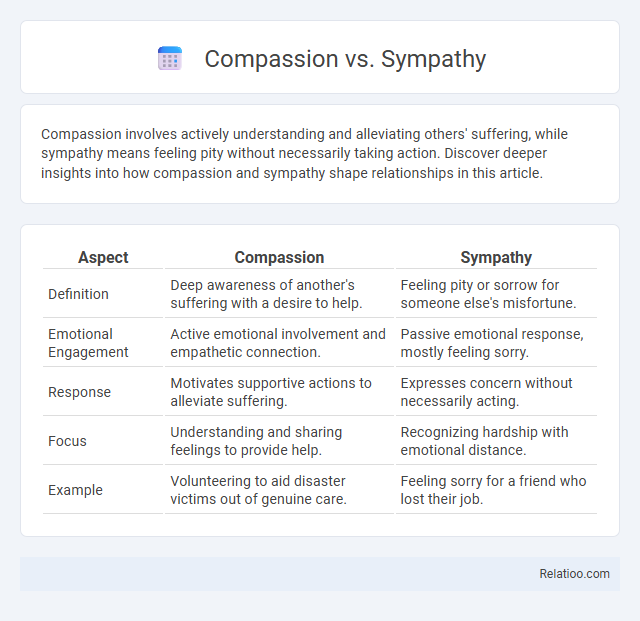Compassion involves actively understanding and alleviating others' suffering, while sympathy means feeling pity without necessarily taking action. Discover deeper insights into how compassion and sympathy shape relationships in this article.
Table of Comparison
| Aspect | Compassion | Sympathy |
|---|---|---|
| Definition | Deep awareness of another's suffering with a desire to help. | Feeling pity or sorrow for someone else's misfortune. |
| Emotional Engagement | Active emotional involvement and empathetic connection. | Passive emotional response, mostly feeling sorry. |
| Response | Motivates supportive actions to alleviate suffering. | Expresses concern without necessarily acting. |
| Focus | Understanding and sharing feelings to provide help. | Recognizing hardship with emotional distance. |
| Example | Volunteering to aid disaster victims out of genuine care. | Feeling sorry for a friend who lost their job. |
Understanding Compassion and Sympathy
Understanding compassion involves recognizing another's suffering and feeling motivated to help, while sympathy is acknowledging someone's pain without necessarily acting on it. Compassion engages empathy and drives supportive actions toward those in distress, whereas sympathy often remains an emotional response without deeper involvement. Your ability to distinguish these emotions enhances meaningful connections and fosters genuine support in relationships.
Defining Compassion: A Deep Dive
Compassion involves recognizing another person's suffering and feeling a genuine desire to alleviate it, rooted in empathy and understanding rather than just pity or surface-level concern. Unlike sympathy, which may express sorrow for someone's hardship, compassion moves deeper by motivating you to actively support and help. Sharing, while related to exchanging experiences or emotions, lacks the intrinsic drive found in compassion to improve the well-being of others through meaningful action.
What Is Sympathy? Key Concepts
Sympathy involves recognizing and feeling concern for someone else's suffering without fully experiencing their emotions or situation, differentiating it from compassion and sharing. It is an emotional response where You acknowledge another person's pain but maintain an emotional distance, offering comfort or support. Key concepts include empathy, emotional understanding, and the ability to convey care while preserving personal boundaries.
Core Differences Between Compassion and Sympathy
Compassion involves feeling genuine concern for someone's suffering and a desire to help alleviate it, whereas sympathy refers to acknowledging another person's pain without necessarily taking action. Compassion drives you to connect emotionally and supportively, while sympathy often remains a more passive acknowledgment of distress. Understanding this core difference enhances your ability to respond empathetically and meaningfully to others' experiences.
Emotional Responses: Compassion vs Sympathy
Compassion involves a deep emotional response where one recognizes another's suffering and feels motivated to alleviate it, fostering an active desire to help. Sympathy is a more passive emotional response characterized by feeling pity or sorrow for someone else's misfortune without necessarily taking action. Sharing emotions creates a mutual connection, but compassion uniquely combines empathy with a proactive intention to support and comfort.
The Role of Empathy in Compassion and Sympathy
Empathy forms the foundation of both compassion and sympathy by enabling you to emotionally connect with another person's experience. Compassion involves a deeper empathetic response that motivates action to alleviate suffering, while sympathy reflects understanding without necessarily prompting intervention. By cultivating empathy, your ability to truly feel and respond to others' emotions becomes more authentic and effective.
Psychological Benefits of Compassion and Sympathy
Compassion and sympathy both foster emotional connection, yet compassion actively motivates helping behaviors, leading to reduced stress and enhanced psychological resilience. Sympathy involves understanding and feeling concern for others' distress, which can promote social bonding and emotional support, but it may also result in emotional fatigue if unbalanced. Sharing emotions, while valuable, does not inherently generate the proactive psychological benefits that compassion triggers through empathetic action and kindness.
Impact on Relationships: Which Matters More?
Compassion fosters deeper emotional connections by actively understanding and alleviating others' suffering, resulting in stronger, more supportive relationships. Sympathy, while expressing concern, often maintains emotional distance and can limit relational intimacy. Sharing personal experiences and emotions cultivates trust and empathy, enhancing relationship resilience and promoting mutual understanding.
Cultivating Compassion Over Sympathy
Cultivating compassion over sympathy involves deeper emotional engagement, where you actively seek to understand and alleviate another's suffering rather than simply feeling pity. Compassion encourages meaningful action and connection, fostering empathy that empowers individuals to support others effectively. This approach strengthens emotional resilience, making your responses more impactful and authentic.
Choosing Compassion in Everyday Life
Choosing compassion in everyday life fosters deeper emotional connections and promotes understanding beyond surface-level reactions such as sympathy. Compassion involves actively recognizing others' suffering and a genuine desire to alleviate it, whereas sympathy often maintains emotional distance. Practicing compassion encourages empathy-driven actions that strengthen relationships and cultivate a supportive community.

Infographic: Compassion vs Sympathy
 relatioo.com
relatioo.com